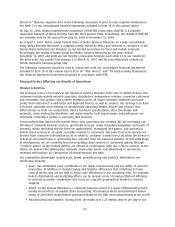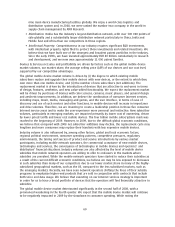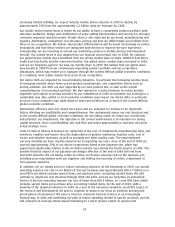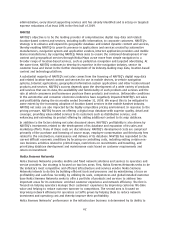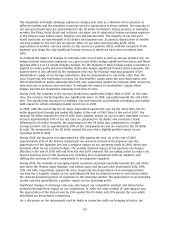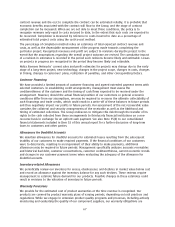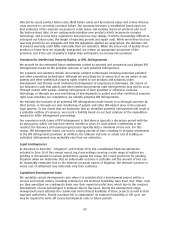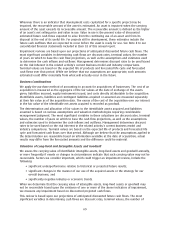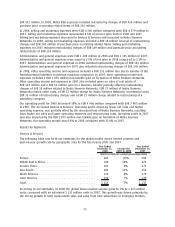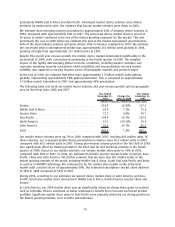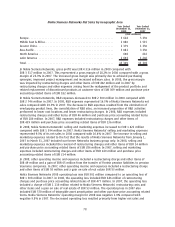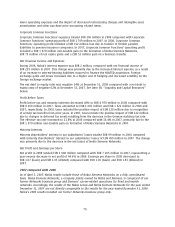Nokia 2008 Annual Report Download - page 70
Download and view the complete annual report
Please find page 70 of the 2008 Nokia annual report below. You can navigate through the pages in the report by either clicking on the pages listed below, or by using the keyword search tool below to find specific information within the annual report.Whenever there is an indicator that development costs capitalized for a specific project may be
impaired, the recoverable amount of the asset is estimated. An asset is impaired when the carrying
amount of the asset exceeds its recoverable amount. The recoverable amount is defined as the higher
of an asset’s net selling price and value in use. Value in use is the present value of discounted
estimated future cash flows expected to arise from the continuing use of an asset and from its
disposal at the end of its useful life. For projects still in development, these estimates include the
future cash outflows that are expected to occur before the asset is ready for use. See Note 8 to our
consolidated financial statements included in Item 18 of this annual report.
Impairment reviews are based upon our projections of anticipated discounted future cash flows. The
most significant variables in determining cash flows are discount rates, terminal values, the number
of years on which to base the cash flow projections, as well as the assumptions and estimates used
to determine the cash inflows and outflows. Management determines discount rates to be used based
on the risk inherent in the related activity’s current business model and industry comparisons.
Terminal values are based on the expected life of products and forecasted life cycle and forecasted
cash flows over that period. While we believe that our assumptions are appropriate, such amounts
estimated could differ materially from what will actually occur in the future.
Business Combinations
We apply the purchase method of accounting to account for acquisitions of businesses. The cost of an
acquisition is measured as the aggregate of the fair values at the date of exchange of the assets
given, liabilities incurred, equity instruments issued, and costs directly attributable to the acquisition.
Identifiable assets, liabilities and contingent liabilities acquired or assumed are measured separately
at their fair value as of the acquisition date. The excess of the cost of the acquisition over our interest
in the fair value of the identifiable net assets acquired is recorded as goodwill.
The determination and allocation of fair values to the identifiable assets acquired and liabilities
assumed is based on various assumptions and valuation methodologies requiring considerable
management judgment. The most significant variables in these valuations are discount rates, terminal
values, the number of years on which to base the cash flow projections, as well as the assumptions
and estimates used to determine the cash inflows and outflows. Management determines discount
rates to be used based on the risk inherent in the related activity’s current business model and
industry comparisons. Terminal values are based on the expected life of products and forecasted life
cycle and forecasted cash flows over that period. Although we believe that the assumptions applied in
the determination are reasonable based on information available at the date of acquisition, actual
results may differ from the forecasted amounts and the difference could be material.
Valuation of Longlived and Intangible Assets and Goodwill
We assess the carrying value of identifiable intangible assets, longlived assets and goodwill annually,
or more frequently if events or changes in circumstances indicate that such carrying value may not be
recoverable. Factors we consider important, which could trigger an impairment review, include the
following:
• significant underperformance relative to historical or projected future results;
• significant changes in the manner of our use of the acquired assets or the strategy for our
overall business; and
• significantly negative industry or economic trends.
When we determine that the carrying value of intangible assets, longlived assets or goodwill may
not be recoverable based upon the existence of one or more of the above indicators of impairment,
we measure any impairment based on discounted projected cash flows.
This review is based upon our projections of anticipated discounted future cash flows. The most
significant variables in determining cash flows are discount rates, terminal values, the number of
69


